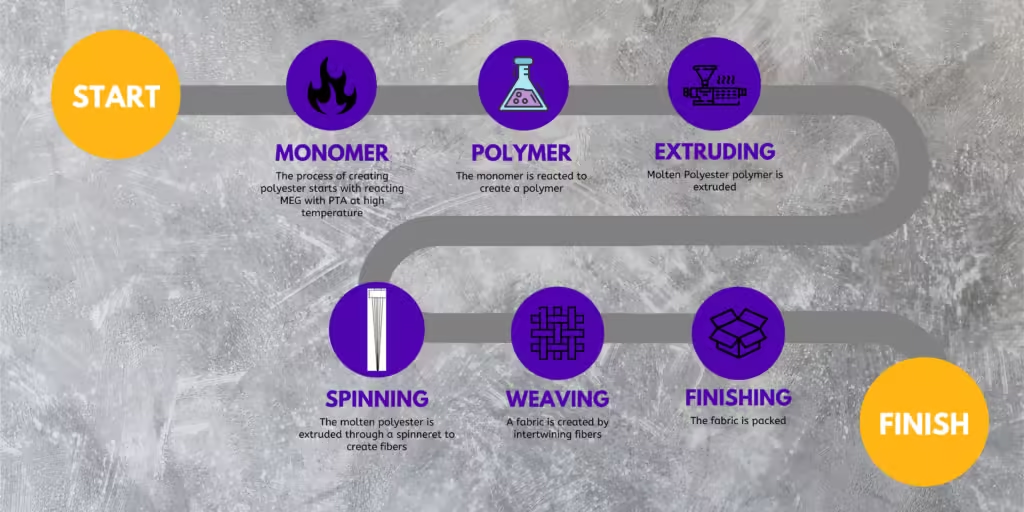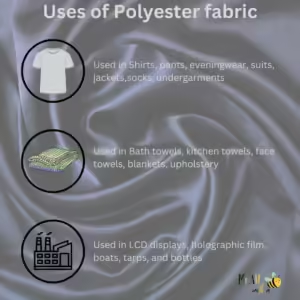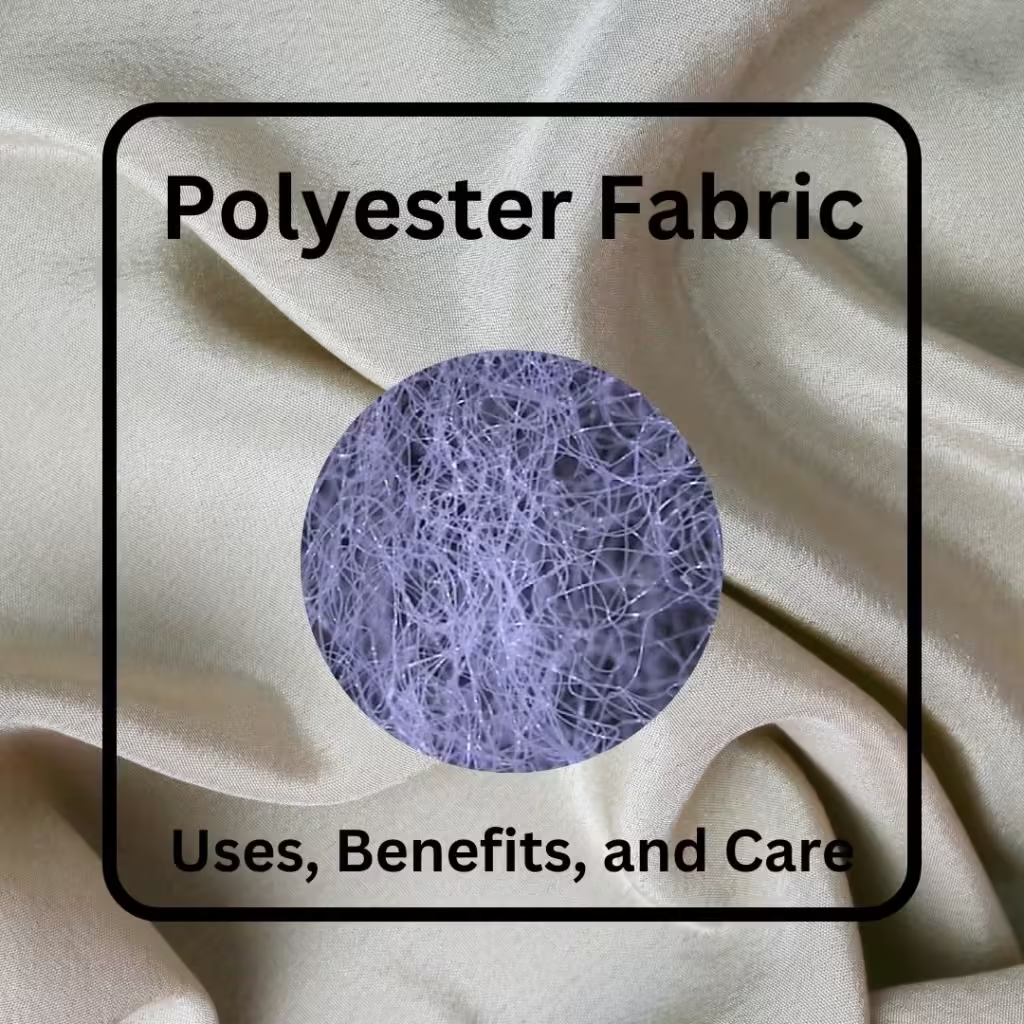Polyester fabric is a versatile and widely used material known for its durability and resilience. Made from synthetic fibers, polyester is resistant to wrinkles, shrinking, and fading, making it a popular choice in both fashion and home textiles. Its lightweight and breathable properties ensure comfort, while its ability to retain shape and resist moisture makes it ideal for activewear and outdoor gear. Polyester can be blended with other fabrics, enhancing its texture and performance. Whether in clothing, upholstery, or industrial applications, polyester’s adaptability and cost-effectiveness continue to make it a staple in the textile industry. This post will discuss in detail polyester’s properties, uses, care, and environmental impact.
What is Polyester?
Polyester is a category of polymers that contain the ester functional group in their main chain. The most common type of polyester is polyethylene terephthalate (PET), which is synthesized through a step-growth polymerization process involving the reaction of pure terephthalic acid (PTA) and monoethylene glycol (MEG).
How Polyester fabric is made

The PET is then melted and extruded through spinnerets, forming long fibers that solidify as they cool. These fibers can be stretched to increase their strength, dimensional stability, and its resistance to stretching and shrinking. These fibers are then cut into short lengths to create staple fibers or left as continuous filaments for yarn production. Finally, the fibers are spun into yarns and woven or knitted into fabric. Polyester has low moisture absorption, making it quick-drying and resistant to mildew and fading from UV exposure.
In addition to its physical properties, polyester is known for its ability to be blended with other fibers, enhancing the performance and aesthetics of textile products. Polyester/cotton blends enhance moisture vapor transmission and wicking properties, crucial for comfort during physical activities (Fiseha et al., 2019). Furthermore, fabrics with higher natural fiber content, such as polyester/flax blends, demonstrate superior air permeability, contributing to overall comfort (Skomra, 2006). Its chemical resistance and durability make it suitable for a wide range of applications, from apparel to industrial textiles.
Properties of Polyester Fabric
- Durability: Polyester is strong and resistant to wear and tear, making it suitable for heavy use.
- Wrinkle Resistance: It holds its shape well and does not wrinkle easily.
- Moisture-Wicking: The fabric can draw moisture away from the skin, keeping wearers dry.
- Quick Drying: It dries quickly, which is beneficial for sportswear and outdoor use.
- Color Retention: Polyester can hold dye well, keeping colors vibrant for longer periods.
Types of Polyester Fabrics
- PET (Polyethylene Terephthalate): The most common form, used in clothing and textiles.
- Recycled Polyester (rPET): Made from recycled plastic bottles, offering a more sustainable option.
- PCDT (Poly-1,4-Cyclohexylene Dimethylene Terephthalate): Less common than PET, it has more elasticity and is often used in heavier textiles, like curtains.
- Microfibers: Very fine polyester fibers used in soft fabrics like cleaning cloths and activewear.
- Blended Polyester: Combined with other fibers (e.g., cotton or wool) to enhance certain properties, like breathability or warmth.
Common Uses of Polyester Fabric

- Clothing: Ideal for activewear, casual wear, and even formal clothing due to its versatility.
- Home Textiles: Used in upholstery, curtains, and bedding.
- Industrial Applications: Found in items like ropes, tents, and automotive textiles due to its strength and resistance.
Care and Maintenance
- Washing: Machine wash in cold or warm water. Hand washing is optional but gentler on the fabric.
- Drying: Tumble dry on low heat or air dry to maintain fabric quality.
- Ironing: Use a low to medium iron setting. Iron inside out to avoid damage.
- Special Care: Avoid bleach, which can weaken fibers.
Environmental Impact
Polyester significantly impacts the environment negatively throughout its life cycle. Its production relies on fossil fuels, which are limited resources also essential for energy and plastics. Refining crude oil releases toxins harmful to land and aquatic life. The process of converting ethylene into polyethylene terephthalate fibers generates additional harmful byproducts. Dyes and treatments used in manufacturing can further contaminate local ecosystems.
Moreover, polyester production often involves exploitative labor practices, exposing workers to toxic chemicals that can cause severe health issues. Major international corporations profit while taking advantage of vulnerable populations. Once in the market, polyester contributes to microfiber pollution also known as microplastics, with washing releasing tiny synthetic fibers into waterways. This pollution threatens marine life and contaminates drinking water.
When discarded, polyester does not biodegrade like natural fibers. It can take centuries to break down, accumulating in ecosystems with no effective removal methods. While plant-based polyester offers a potential alternative, its market impact remains uncertain, leaving the environmental issues associated with traditional polyester largely unresolved. In short
- Sustainability: Polyester production relies on petroleum, making it less sustainable than natural fibers.
- Recycling: Recycled polyester (rPET) offers a more eco-friendly option, as it reduces plastic waste.
- Environmental Concerns: While durable, polyester is not biodegradable, posing environmental risks compared to natural fibers.
Advantages and Disadvantages
- Pros: Durable, easy to care for, and affordable.
- Cons: Not biodegradable, may feel less breathable compared to natural fibers.
Conclusion
Polyester fabric remains a practical choice for a wide range of applications due to its durability, versatility, and cost-effectiveness. Its resistance to wrinkles, fading, and stretching makes it ideal for everything from clothing to home textiles and industrial uses. However, it is essential to acknowledge the environmental downsides associated with its production and disposal. Fortunately, the emergence of recycled polyester options provides a promising step toward sustainability, reducing the need for virgin materials and minimizing waste. When selecting textiles, it is crucial to weigh the benefits of polyester against its environmental impact and consider more sustainable alternatives that align with eco-friendly practices.
FAQs
Q1: Is polyester breathable?
Yes, but it may not be as breathable as cotton.
Q2: Can polyester be recycled?
Yes, recycled polyester is made from plastic waste like bottles.
Q3: Does polyester shrink?
Polyester generally resists shrinking. Click this link to learn more about polyester shrinking.
Q4: Is polyester good for sensitive skin?
It may not be ideal for sensitive skin, as it can trap heat.
Thank you for reading, for more interesting articles visit our homepage.



